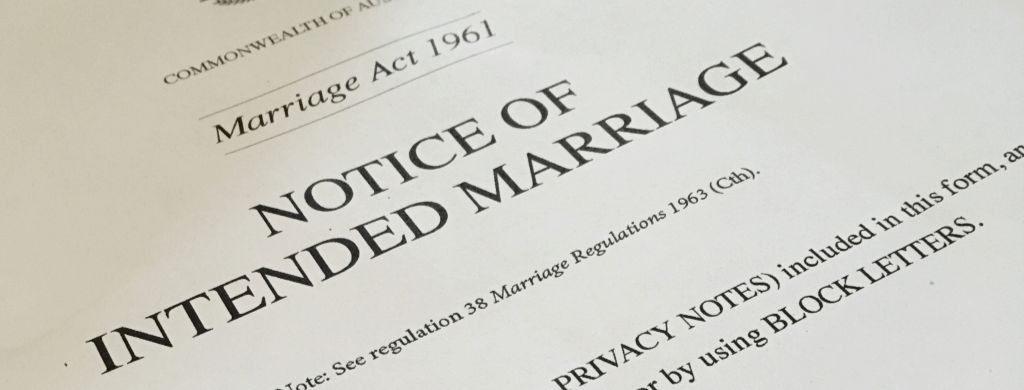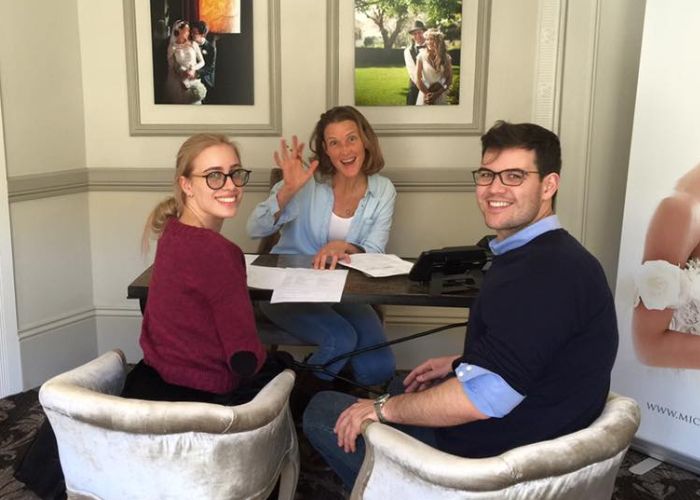
If you’re getting married in Australia, you are going to encounter a form called the ‘NOIM’. Read on to learn what it is, why it’s so important and how to complete it correctly.
Author: Meggan Brummer
If we haven’t met before - I am an award-winning Marriage Celebrant in Sydney, Australia.
I’ve married hundreds of couples over the last 12 years and have over 23 years experience as a professional writer.
What is a NOIM?
The NOIM is a legal document that every couple who want to be married under Australian law must complete.
‘NOIM’ is short for ‘Notice of Intended Marriage’.
You can download the form via the Attorney Generals website.
Why do you have to complete a NOIM?
This document ensures that before entering into a legal marriage there is a cooling off period.
It gives both parties a month to think about whether they really do want to marry the other person.
By when do you have to complete your NOIM?
The NOIM must be lodged no sooner than 18 months and no later than 1 month before your intended wedding day, unless a prescribed authority has agreed to a ‘shortening of time‘.
To be considered ‘lodged’, the NOIM must be signed, witnessed and in the hands of your marriage celebrant.
What do I mean by 1 month? Well, if for example you wish to get married on 3 March 2024, the NOIM needs to be completed and given or emailed to your Celebrant no later than 3 February 2024.
If this requirement has not been met then on the 3rd March your celebrant would only be able to perform a ‘Commitment Ceremony’, not a legally recognised marriage ceremony.
Let me stress once more that the 1 month period applies from the time the completed NOIM is handed to your celebrant. It does not apply from the date you signed it. So if you sign it and just leave it in a drawer – that doesn’t count.
If both of you are able to sign this document at least 1 month before your wedding – great. But if only one of you is able to do this the NOIM can still be lodged with 1 signature. The other party can sign in the presence of the celebrant anytime before the ceremony, even on the wedding day itself.
For couples coming from overseas to get married in Australia – you can get married straight off the plane as long as you’ve correctly lodged your NOIM with your celebrant.
Tip: Most couples choose their marriage celebrant before they complete the NOIM. Doing it this way not only means you have the celebrant’s support with completing the NOIM – it will also likely save you money. For example, Births, Deaths and Marriages (BDM) in NSW currently charge a $169 NOIM lodgement fee. It’s uncommon for celebrants to charge anything for lodging the NOIM.

Legal requirements for completing the NOIM
Before completing the NOIM, you need to fulfil 3 requirements…
- You must be over 18. If you’re under 18, you’re not of marriageable age in Australia and cannot get married unless you obtain an order from a judge or magistrate under section 12 of the Act.
- You can’t be directly related to the person you’re going to marry. In Australia ‘directly related’ means your brother, sister, parent, or grandparent. This applies just the same when the direct relationship is through adoption, not birth. Under Australian law, you can marry other relatives such as an aunt, uncle, niece, nephew or cousin.
- You can’t be currently married to someone else.
How To Complete The NOIM
Fill in the boxes on the NOIM online or print the NOIM and manually complete it using BLOCK letters.
It’s better if you can complete it electronically so your celebrant can easily read it and have less chance of recording your information incorrectly. This in turn will mean less chance of errors on your marriage certificate later.
Correcting an error on your marriage certificate after your wedding is very time-consuming and costs $60. However, if you make a mistake on your NOIM you can easily correct it by simply crossing out the mistake, entering the correct details & writing your initials in the extreme left or right hand column – whichever is closest to where the error was made.
Remember, because this is a legal document, it’s a criminal offence for a person to put false information in this document.
- Item 1 – It is up to each of you to decide how you want to describe yourselves. You can either describe yourself as a ‘bride,’ a ‘groom’ or a ‘partner.’
- Item 2 – Your surname.
- Item 3 – All your given names: your first name, followed by all middle names. The names you put on your NOIM must reflect your full name in your passport. A shortened version of your name is not acceptable.
- Item 4 – This item is optional. If you choose to complete it you are free to decide how you want to describe your gender. Non-binary includes “unspecified” or ‘ indeterminate” and people who do not exclusively identify as either female or male.
- Item 5 – Occupation. Whatever you put here will end up on the legal marriage certificate that BDM generate (if you or your celebrant applies for it). Remember, your occupation is what you do, not where you work. eg. If you work in Politics don’t write ‘politics,’ write ‘Politician.’
- Item 6 – Your current place of residence at the time of signing the NOIM.
- Item 7 – In Item 7 the term ‘conjugal status’ means whether you’ve been legally married before. You should not include information about relationships other than married relationships. If your status is ‘divorce pending’ that’s fine but the divorce must take affect before your marriage can be solomised.
- Item 8 – If you were born in Australia, for your birth place put the city or town + the state or territory. If you were born outside Australia, put the city or town, state or province (if applicable) + country you were born in.
- Item 9 – Date of birth.
- Item 10 – Are you related to your partner?
- Item 11 – Parent 1’s current full name, including any middle names. Remember, your mother’s surname when she was born may be different to the surname she has now.
- Item 12 – Parent 1’s full name as at the time of their birth, including any middle names.
- Item 13 – Parent 2’s current full name, including any middle names.
- Item 14 – Parent 2’s full name as at the time of their birth, including any middle names.
- Item 15 – The country parent 1 was born in.
- Item 16 – The country parent 2 was born in.
- Item’s 17 – 30 – Must be completed by your celebrant.
What if there’s information you don’t know & can’t obtain?
If you’re unable, after reasonable inquiry, to state any information required in the NOIM, you should write ‘unknown’ in the relevant space of the NOIM and give your Celebrant a statutory declaration that explains why you are unable to provide the information.
A Statutory declaration is not required where information is unknown for items 11 to 16.
Additional Documentation
In addition to the NOIM, you need to provide your Marriage Celebrant with the following;
- Evidence of your date & place of birth. You could show your birth certificate, an official extract from a birth register, or an Australian or overseas passport. Passports that have expired with in the last 3 years are still acceptable. But you cannot use a cancelled passport. If you can’t find your birth certificate and you’re Australian you can easily get another one. Just hop onto the birth deaths and marriages website (BDM) of the State you live in and apply for one and they’ll post it to you. If you’ve moved to your current country of residence as a refugee and these documents no longer exist then you can provide a statutory declaration as proof of your date and place of birth.
- Evidence of divorce or death. If you are divorced or your previous spouse died, you need to show evidence of the divorce or death of that spouse before you can marry. If you’ve been married and divorced more than once – you only need to show the divorce certificate of your most recent divorce. In Australia, you can easily get hold of your divorce order online from the family court.
- Photographic ID. Before your marriage can take place your Marriage Celebrant must also be satisfied that you are the 2 people named in the NOIM. Photographic evidence of identity, such as your passport, drivers license, proof of age card or an official identity card will enable your Celebrant to meet this requirement.
Who can witness you signing the NOIM in Australia?
Assuming you are in Australia, your celebrant will usually witness the signing of your NOIM, either in person or over a video call.
Besides an authorised celebrant, if you are in Australia, the following may also witness you signing the NOIM;
- A Justice of the peace
- A barrister or Solicitor
- A medical practitioner (a Doctor)
- A member of the Police Force either Federal or state/territory.
You will need to show the person witnessing your signature some form of photo ID to prove who you are.
Important: This is a legal document. It is a criminal offence for the witness to sign the doc if they know it contains a false statement or error or is defective.
Who can witness you signing your NOIM outside of Australia?
If you are outside of Australia at the time of signing your NOIM, your celebrant cannot legally be your witness.
These are the people who can witness your signature if you are overseas;
- An Australian consulate officer
- An Australian diplomatic officer
- A notary public
- An employee of the Commonwealth authorised and a paragraph 3C of the Consular Fees Act 1955
- An employee of the Australian Trade Commission authorised under paragraph, 3-D of the Consular fees Act 1955
Lodging The NOIM.
Once you’ve signed your NOIM in front of an authorised witness you need to either give or scan and email your NOIM to your Marriage Celebrant, along with your passport (or whatever photo identification you use) and divorce certificate if relevant.
The NOIM they receive and print becomes the NOIM that’s used from that moment onwards. You don’t have to keep the original NOIM, but it’s not a bad idea to keep it in case the one you scanned and sent is illegible and you need to send it again.
Final Thoughts
In most instances, completing the NOIM, providing you follow the advice given here, is straightforward and will ensure your marriage ceremony can proceed without a hitch. Just remember to give yourself plenty of time to get it done and don’t leave it to the last minute.
I hope that’s been helpful.
